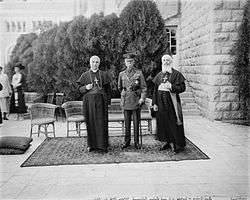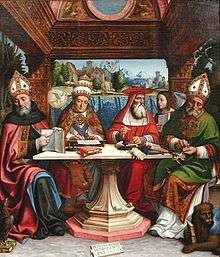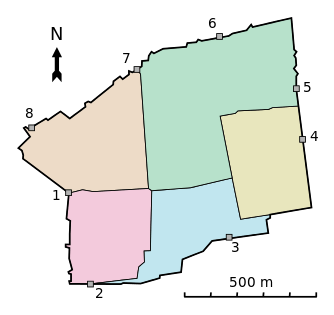Latin Patriarchate of Jerusalem
| Patriarchate of Jerusalem Patriarchatus Hierosolymitanus Latinorum הפטריארכיה בירושלים (Hebrew) بطريركية القدس (Arabic) | |
|---|---|
| Location | |
| Country |
Cyprus Israel Jordan Palestine |
| Ecclesiastical province | None, exempt, i.e. directly subject to the Holy See |
| Metropolitan | Jerusalem |
| Subdivisions | Vicarates |
| Statistics | |
| Population - Catholics |
(as of 2012) 161,400 |
| Parishes | 66 |
| Information | |
| Denomination | Catholic |
| Sui iuris church | Latin Church |
| Rite | Roman Rite |
| Established |
|
| Cathedral | Basilica of the Holy Sepulchre |
| Co-cathedral | Co-Cathedral of the Most Holy Name of Jesus |
| Secular priests | 66 |
| Current leadership | |
| Pope | Francis |
| Patriarch | Vacant |
| Auxiliary Bishops | |
| Apostolic Administrator | Pierbattista Pizzaballa |
| Vicar General | Imad Twal |
| Episcopal Vicars |
|
| Emeritus Bishops | |
| Website | |
| lpj.org | |
Latin Patriarchate of Jerusalem (Latin: Patriarchatus Latinus Hierosolymitanus) is the Catholic episcopal see of Jerusalem, officially seated in the Church of the Holy Sepulchre. It was originally established in 1099 with the Kingdom of Jerusalem encompassing the newly conquered territories in the Holy Land. From 1374-1847 it was a titular see, the Patriarchs of Jerusalem being based at the Basilica di San Lorenzo fuori le Mura in Rome. A resident Latin Patriarch was re-established in 1847 by Pius IX.
The Latin Patriarch of Jerusalem is now the diocesan archbishop of Latin Church Catholics of the Catholic Archdiocese of Jerusalem and has jurisdiction for all Latin Catholics in Israel, the Palestinian territories, Jordan and Cyprus. The Latin Patriarch of Jerusalem also holds the office of Grand Prior of the Order of the Holy Sepulchre.
It is exempt, i.e. directly subject to the Holy See (and exceptionally its Roman Congregation for the Oriental Churches, which normally handles Eastern Catholics), without an ecclesiastical province, hence has no metropolitan function.
Vacant as of 2017, the most recent Latin Patriarch of Jerusalem was Fouad Twal who resigned in 2016 upon reaching the age limit of 75.
The title of Patriarch in the Latin Church is retained by only four archbishops (since Benedict XVI relinquished the papal title of "Patriarch of the West" in 2006): the Latin Patriarchs of Jerusalem, of Venice, of Lisbon and of the East Indies. Until 1964, there had also been the honorary patriarchal titles of Constantinople, Alexandria and Antioch; still others were abolished earlier.
The title of "Patriarch of Jerusalem" is also used by the Eastern Orthodox Patriarch of Jerusalem, the Armenian Patriarch of Jerusalem, as well as, titularly (along Alexandria), by the Melkite Patriarch.
Statistics and extent
As per 2015, it pastorally served 293,053 Catholics in 66 parishes with 464 priests (81 diocesan, 383 religious), 9 deacons, 1,652 lay religious (590 brothers, 1,062 sisters) and 55 seminarians.
The proper Archdiocese of the patriarchal see of Jerusalem has jurisdiction over all 'Latin Church' Catholics (not Eastern Catholics) in the Holy Land (Israel, Palestine and Jordan) as well as Cyprus. In the Holy city of Jerusalem, the Latin Catholic community is the largest Christian community, with some 4,500 people out of an estimated Christian population of about 11,000.[1]
Special churches
In Jerusalem, the patriarch has his Cathedral archiepiscopal see, a Minor Basilica and World Heritage Site: the Basilica of the Holy Sepulchre, as well as the Co-Cathedral, also a World Heritage Site: Co-Cathedral of the Most Holy Name of Jesus, and four other Minor Basilicas and World Heritage Sites: Basilica of the Agony, Basilica of St. Stephen, Dormition Abbey of the Virgin Mary and St. Anne’s Church.
Other cities in the archdiocese have more Minor Basilicas: Basilica of the Annunciation in Nazareth, Basilica of the Transfiguration in Mount Tabor, Carmelite Monastery of Stella Maris in Haifa and Church of Emmaus in Emmaus (El Qubeibeh), and two other World Heritage Sites, both in Bethlehem : Church of St. Catherine and Church of the Nativity.
History
Antecedents
Jerusalem (in Latin also Hierosolyma) was one of the Apostles' original bishoprics. It was renamed Aelia Capitolina in 135 AD, again Jerusalem in 325. In 451 it was promoted as Patriarchal See. After 649, Pope Martin appointed John of Philadelphia (Amman) as Patriarchal vicar of Jerusalem to replace Sergius of Jaffa.
In 1054, the Great Schism split Christianity into the Eastern Orthodox Church—which consisted of the four Orthodox Christian Patriarchs of Antioch, Jerusalem, Constantinople and Alexandria—under the stewardship of Constantinople; and the Catholic Church, which consisted of the Pope of Rome and virtually all of Western Christianity. Apart from the Maronites, most Christians in the Holy Land came under the jurisdiction of the Eastern Orthodox Patriarchate of Jerusalem.
Latin Kingdom of Jerusalem
In 1099, the Western Crusaders captured Jerusalem, set up the Kingdom of Jerusalem and established a Latin hierarchy under a Latin Patriarch (in communion with Rome), while expelling the Orthodox Patriarch. The Latin Patriarchate was divided into four archdioceses—their heads bearing the titles of Archbishop of Tyre, Archbishop of Caesarea, Archbishop of Nazareth and Archbishop of Petra—and a number of suffragan dioceses. The Latin Patriarch took over control of the Latin quarter of the city of Jerusalem (the Holy Sepulchre and the immediate surroundings) as his Metropolitan see, and had as his direct suffragans the bishops of Lydda-Ramla, Bethlehem, Hebron and Gaza, and the abbots of the Temple, Mount Sion and the Mount of Olives.
The Latin Patriarch resided in Jerusalem from 1099 to 1187, while Orthodox Patriarchs continued to be appointed, but resided in Constantinople. In 1187, the Crusaders were forced to flee Jerusalem, and the Latin Patriarchy moved to Acre (Akka), while the Orthodox Patriarch returned to Jerusalem. The Catholic Church continued to appoint residential Latin Patriarchs. The Crusader Kingdom of Jerusalem endured almost 200 years until the last vestiges of the Kingdom were conquered by the Muslim Mamluks in 1291, and the Latin hierarchy was effectively eliminated in the Levant.
With the fall of Acre, the Latin Patriarch moved to Cyprus in 1291.
Titular Latin Patriarchate of Jerusalem
From 1374, the Catholic Church continued to appoint titular Patriarchs of Jerusalem, who were based at the Basilica di San Lorenzo fuori le Mura in Rome.
In 1342, Pope Clement VI officially committed the care of the Holy Land to the Franciscans and the Franciscan Custos of the Holy Lands (The Grand Masters of the Order of the Holy Sepulchre) held the title ex officio under the Papal bull Gratiam agimus by Pope Clement VI, unless someone was specifically appointed to the honorary office.
Yet in 1570 it gained territories from the suppressed Archdiocese of Nicosia and Diocese of Paphos, and in 1571 it gained more territories from the suppressed Diocese of Limassol and Diocese of Famagosta, all in former Crusader kingdom Cyprus, which had fallen to the Ottoman Turks.
Modern Patriarchate of Jerusalem
A resident Latin Patriarch was re-established in 1847 by Pius IX, with Bishop Joseph Valerga being appointed to the office. Though officially superseding the Franciscans, Valerga was also the Grand Master of the Order. On Valerga's death in 1872, Vincent Braco was appointed, and following his death in 1889, the Ottoman Sultan authorised the re-establishment of a Latin hierarchy. The Grand Masters of the Order continued to be named as Latin Patriarchs until 1905.
The Co-Cathedral of the Most Holy Name of Jesus is the principal, or "mother" Church of the Latin Patriarchate, the church in which the Latin Patriarch of Jerusalem has his official chair (cathedra).[2] However, the Basilica of the Holy Sepulchre has the title of cathedral of the patriarchate. The residence of the Patriarch is in the Old City, near the Co-Cathedral, while the seminary, which is responsible for the liturgical education, is in Beit Jala, a town 10 km south of Jerusalem, where it has been since 1936.
In 1987, Michel Sabbah became the first native Palestinian to be appointed Latin Patriarch. The Latin Patriarch of Jerusalem is now the diocesan archbishop of Latin Catholics of the Catholic Archdiocese of Jerusalem and has jurisdiction for all Latin Church Catholics in Israel, the Palestinian territories, Jordan and Cyprus.
The prerogatives of the Patriarch in his relation with government authorities overlap with the prerogatives of the Vatican Apostolic Nuncio to Israel, following the Fundamental Agreement between Israel and the Vatican signed on 30 December 1993, and the Apostolic delegate to the Palestinian Authority.
In 2003, the Latin Patriarch was one of the signatories of the "Statement regarding the Separation Wall by heads of Churches in Jerusalem,"[3] and in 2006, the Jerusalem Declaration on Christian Zionism, which repudiates Christian Zionism as inconsistent with Christian teaching.[4][5] In 2008, Sabbah also signed the Kairos Palestine Document (published in 2009, after Sabbah term) against Israeli occupation.
In 2008, Archbishop Fouad Twal was appointed Patriarch to succeed Patriarch Michel Sabbah.[6] He exercised his mandate from June 21, 2008, until June 24, 2016, when he reached the canonical age of retirement and Pope Francis accepted his resignation. Pope Francis appointed Pierbattista Pizzaballa as Apostolic Administrator sede vacante of the Latin Patriarchate of Jerusalem, until the appointment of a new Patriarch.
Pope Paul VI visited in January 1964, Pope John Paul II in March 2000, Pope Benedict XVI in May 2009 and Pope Francis in May 2014.
List of Latin Patriarchs of Jerusalem
Prior to the Great Schism, there were no separate Latin and Greek Orthodox Churches, and thus no separate Patriarchs. For Patriarchs of Jerusalem of the unified Church prior to the Schism, see Greek Orthodox Patriarch of Jerusalem.
- Arnulf of Chocques (1099)
- Dagobert of Pisa (1099–1101)
- Maurice of Porto (1101–1102), ad interim
- Ehremar (1102–1105)
- Dagobert of Pisa (restored) (1105)
- Ghibbelin of Arles (1107–1112)
- Arnulf of Chocques (re-appointed) (1112–1118)
- Garmond of Picquigny (1119–1128)
- Stephen of La Ferté (1128–1130)
- William of Malines (1130–1145)
- Fulk of Angoulême (1146–1157)
- Amalric of Nesle (1157–1180)
- Heraclius (1180–1191)
Jerusalem itself was lost in 1187; seat of the Patriarch moved (with the kingdom in retreat) to Acre.
- Rodolfo (1191–1192)
- Michele de Corbeil (1193–1194)[7]
- Aimaro Monaco dei Corbizzi (1194–1202)
- Loffredo Errico Gaetani (1202–1204)
- Albert Avogadro (1204–1214)
- Raoul of Merencourt (1214–1225)
- Gerold of Lausanne (1225–1238)
- vacant (1238–1240); Jacques de Vitry appointed but never served
- Robert of Nantes (1240–1254)
- Jacques Pantaléon (1255–1261), future Pope Urban IV of Rome
- William II of Agen (1261–1270)
- Thomas Agni of Cosenza (1271–1277)
- John of Vercelli (1278–1279)
- Elijah (1279–1287)
- Nicholas of Hanapes (1288–1294)
Acre lost in 1291; see in exile moved to Cyprus, then Rome after 1374; titular patriarchs until 1847.
- Landolfo (1295–1304)[7]
- Antony Bek (1306–1311), also Prince-Bishop of Durham in England from 1284 to 1310
- Pierre Pleinecassagne (1314–1318)[7]
- Pierre (1314–1318)[7]
The Franciscan Custodian of the Holy Land held the title from 1342 to 1830 under the Papal bull Gratiam agimus by Pope Clement VI. The bull declared the Franciscans as the official custodians of the Holy Places in the name of the Catholic Church, "unless someone was specifically appointed in the honorary office".[8]
- Raymond Bequin (Raimondo Beguin), O.P. (1324–1329 Died[7][9]
- Peter Paludanus (Pierre de Palude or Pietro de la Palude), O.P. (1329–1342 Died)[10]
- Élie de Nabinal, O.F.M. (1342)[7]
- Pierre de Casa, O. Carm. (1342–1348)[7]
- Emanuele de Nabinal, O.F.M. (1345)[7]
- Guillaume Amici (Lamy) (1349–1360)[7]
- Philippe de Cabassole (1361–1368)[7]
- Guglielmo Militis, O.P. (1369–1371)[7]
- Guilherme Audibert de la Garde (1371–1374)[7]
- Philippe d'Alençon de Valois (1375–1378)[7]
- Guglielmo da Urbino, O.F.M. (1379–?)[7]
During the Western Schism, the Patriarch was appointed by both Popes resulting in overlapping appointments.
- Named by the Pope of Rome:
- Named by the Pope of Avignon:
- Francisco Clemente Pérez Capera (1419–1429)[7]
- Leonardo Delfino (patriarch), O.F.M. (1430–1434)[7]
- Biagio Molino (1434–1447 Died)[7][11]
- Cristoforo Garatoni (Apostolic Administrator 1448–1449)[7]
- Giovanni Bessarione (Basilios Bessarion) (Apostolic Administrator 1449–1458)[7]
- Lorenzo Zanni (Lorenzo Zane) (1458–1460)[7][12]
- Louis de Haricuria (1460–1479)[7]
- Bartolomeo della Rovere, O.F.M. (1480–1494)[7]
- Giovanni Antonio Sangiorgio (1500–1503)
- Bernardino López de Carvajal y Sande (1503–1511 Resigned)
- ...
- Rodrigo de Carvajal (1523–1539)
- Alessandro Farnese (1539–1550)
- Cristoforo Spiriti (1550–1556 Died)[13]
- Antonio Elio (Antonius Helius) (1558–1576)
- Gian Antonio Facchinetti de Nuce (1576–1584), future Pope Innocent IX of Rome
- Scipione Gonzaga (1585–1588)
- Fabio Blondus de Montealto (Fabio Biondi) (1588–1618)[14][15]
- Francesco Cennini de' Salamandri (1618–1621)[14]
- Diofebo Farnese (1621–1622 Died)[14]
- Alfonso Manzanedo de Quiñones (1622–1627 Died)[14][16]
- Domenico de' Marini (patriarch) (1627–1635 Died)[14]
- Giovanni Battista Colonna (1636–1637 Died)[14]
- Tegrimus Tegrimi (1638–1641 Died)[17]
- Aegidius Ursinus de Vivere (1641–1647 Died)[7][14][18]
- unknown
- Camillo Massimo (1653–1671)[14]
- Egidio Colonna (patriarch), O.S.B. (1671–1686 Died)[19]
- Bandino Panciatichi (1689–1690)[19]
- Niccolo Pietro Bargellini (1690–1694 Died)[19]
- Francesco Martelli (1698–1706)[19]
- Muzio Gaeta (1708–1728)[19][20]
- Vincent Louis Gotti (1728–1729)[19]
- Pompeo Aldrovandi (1729–1734)[19]
- Tommaso Cervini (1734–1751)
- Tommaso de Moncada (1751–1762)
- Giorgio Maria Lascaris (1762–1795)
- vacant (1795–1800)
- Michele di Pietro (1800–1821)
- Francesco Maria Fenzi (1816–1829)
- Paolo Augusto Foscolo (1830–1847), later Latin Patriarch of Alexandria, 1847–1860

Restoration of resident Latin Patriarchs of Jerusalem in 1847.
- Joseph Valerga (1847–1872)
- Giovanni Vincenzo Bracco (1872–1889)
Latin patriarchate hierarchy re-established in 1889.
- Luigi Piavi (1889–1905)
- Auxiliary Bishop: Pasquale Appodia (1891.02.13 – 1901.11.07)
- vacant (1905–1906)
- Filippo Camassei (1906–1919)
- Luigi Barlassina (1920–1947)
- Auxiliary Bishop: Godric Kean (1924.07.14 – 1928.12)
- Auxiliary Bishop: Francesco Fellinger (1929.02.26 – 1940.07.22)
- vacant (1947–1949)
- Auxiliary Bishop: Vincent Gelat (1948.04.30 – 1968.01.19)
- Alberto Gori (1949–1970)
- Vicar general: Bishop Pier Giorgio Chiappero, O.F.M. (1959.08.31 – 1963.07.15)
- Auxiliary Bishop: Hanna Kaldany (1964.01.04 – 1996.05.14)
- Auxiliary Bishop: Neemeh Simaan (1965.09.21 – 1981.05.25)
- Giacomo Giuseppe Beltritti (1970–1987)
- Auxiliary Bishop: Salim Sayegh (1981.11.26 – 2012.01.19)
- Michel Sabbah (1987–2008)
- Auxiliary Bishop: Kamal Hanna Bathish (1993.04.29 – 2007.06.09)
- Fouad Twal (2008–2016)
- Pierbattista Pizzaballa (as Apostolic Administrator, 2016– ...)[21]
- Auxiliary Bishop (1993.04.29 – ...): Giacinto-Boulos Marcuzzo, Titular Bishop of Emmaus
- Auxiliary Bishop (2010.03.31 – ...): William Hanna Shomali, titular Bishop of Lydda
Auxiliary episcopate
- Auxiliary Bishop: Archbishop Maroun Elias Nimeh Lahham (2012.01.19 – 2017.02.04)
- Auxiliary Bishop: Jean-Baptiste Gourion, O.S.B. Oliv. (2003.08.14 – 2005.06.23)
See also
References
- ↑ Jerusalem Post, May 8, 2009 - Depths of despair
- ↑ http://www.lpj.org/newsite2006/administration/co-cathedral-book.pdf
- ↑ Statement regarding the Separation Wall by heads of Churches in Jerusalem.
- ↑ Voltaire.net
- ↑ HCEF.org
- ↑ Pope Names Arch. Fouad Twal Patriarch of Jerusalem - Vatican Radio 21/6/08 Archived 2012-09-11 at Archive.is
- 1 2 3 4 5 6 7 8 9 10 11 12 13 14 15 16 17 18 19 20 21 22 23 24 25 26 27 28 29 "Patriarchal See of Jerusalem" GCatholic.org. Gabriel Chow. Retrieved September 28, 2016
- ↑ The Bull of Clement VI (1342)
- ↑ "Patriarch Raymond Bequin, O.P." Catholic-Hierarchy.org. David M. Cheney. Retrieved September 25, 2016
- ↑ "Patriarch Pierre de Palude, O.P." Catholic-Hierarchy.org. David M. Cheney. Retrieved September 25, 2016
- ↑ "Patriarch Biaggio Molino" Catholic-Hierarchy.org. David M. Cheney. Retrieved September 28, 2016
- ↑ "Patriarch Lorenzo Zanni (Zane)" Catholic-Hierarchy.org. David M. Cheney. Retrieved September 28, 2016
- ↑ "Patriarch Cristoforo Spiriti" Catholic-Hierarchy.org. David M. Cheney. Retrieved September 28, 2016
- 1 2 3 4 5 6 7 8 Gauchat, Patritius (Patrice). HIERARCHIA CATHOLICA MEDII ET RECENTIORIS AEVI Vol IV. p. 203.
- ↑ Catholic-hierarchy.org: "Patriarch Fabio Biondi (Blondus de Montealto)" retrieved February 14, 2016
- ↑ "Patriarch Alfonso Manzanedo de Quiñones" Catholic-Hierarchy.org. David M. Cheney. Retrieved December 27, 2016
- ↑ "Patriarch Tegrimus Tegrimi" Catholic-Hierarchy.org. David M. Cheney. Retrieved January 4, 2017
- ↑ "Patriarch Aegidius Ursinus de Vivere" Catholic-Hierarchy.org. David M. Cheney. Retrieved December 25, 2016
- 1 2 3 4 5 6 7 Ritzler, Remigius; Sefrin, Pirminus. HIERARCHIA CATHOLICA MEDII ET RECENTIORIS AEVI Vol V. p. 220.
- ↑ "Patriarch Muzio Gaeta (Sr.)" Catholic-Hierarchy.org. David M. Cheney. Retrieved December 17, 2016
- ↑ Crux Catholic Media: "Pope’s potential masterstroke takes charge in the Holy Land" by John L. Allen Jr. September 22, 2016
Sources and external links
- Latin Patriarchate of Jerusalem website
- Saint James Vicariate for Hebrew Speaking Catholics
- GigaCatholic, Listing Latin Patriarchs of Jerusalem
- , Catholic Hierarchy website
- Homily of John Paul II in the church of the Holy Sepulchre

